Authentic Pad Thai at Home! (VIDEO)
This post may contain affiliate links. Please read our disclosure policy.
Pad Thai is one of the most famous Thai noodle dishes and there’s good reason why – there is nothing in the world quite like it! I learned how to make authentic Pad Thai during my travels in Thailand and now I can share all of the tips I learned on preparing it perfectly at home!
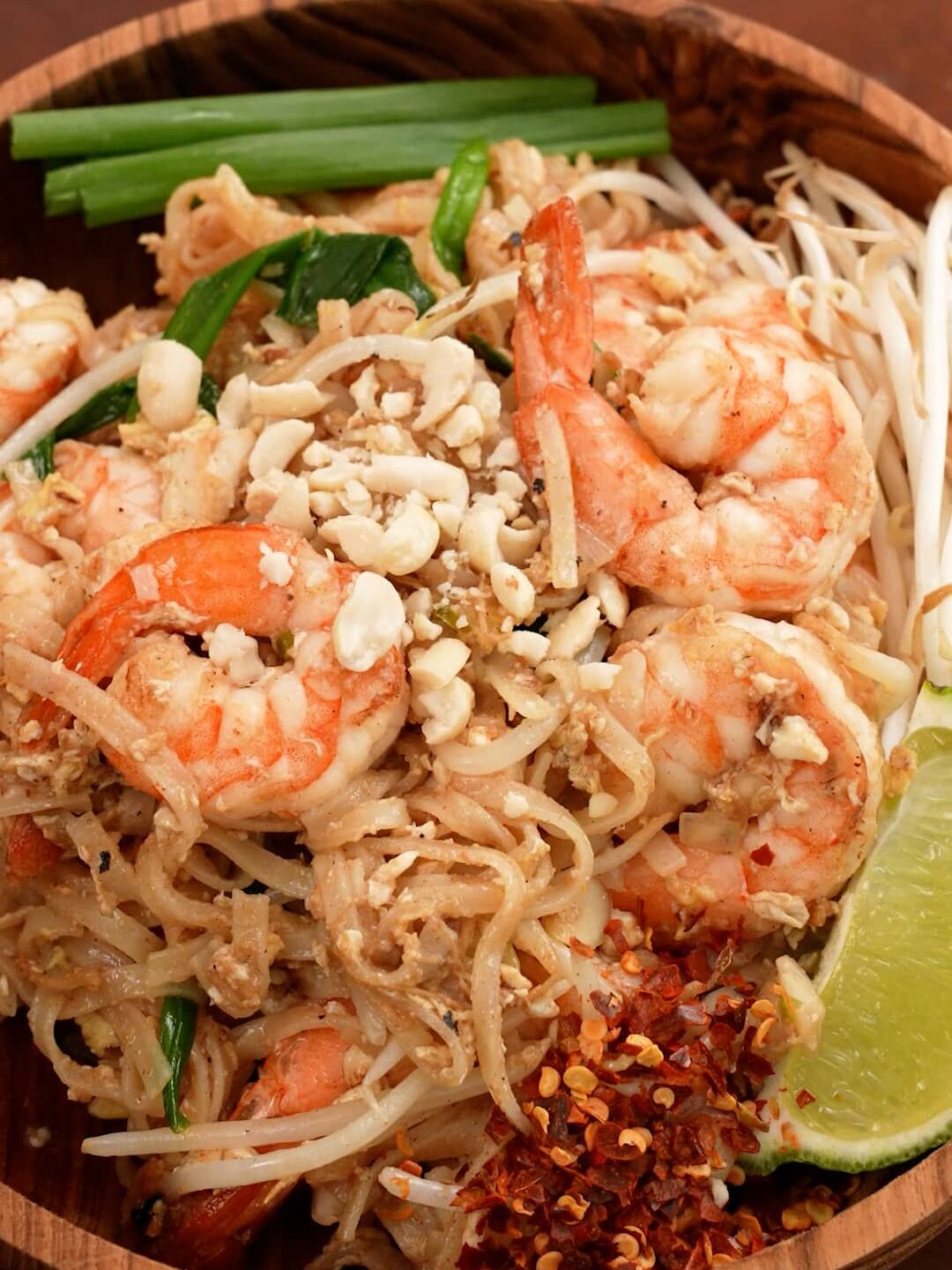
Watch the Pad Thai Recipe Video!
Table of Contents
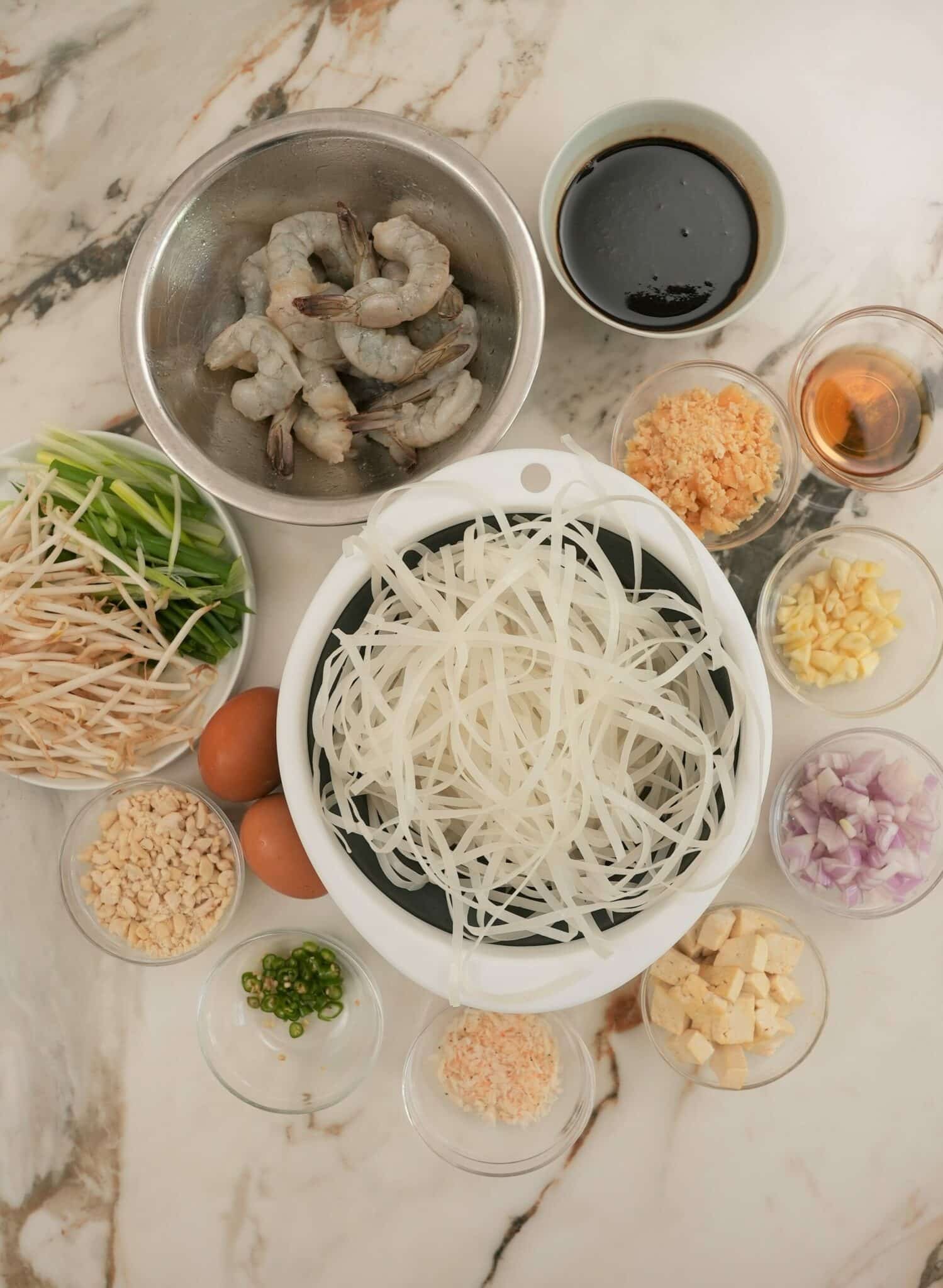
Key Ingredient Tips (and Substitutions)
Like a lot of people, I always thought Pad Thai was a difficult dish to make at home – until I took a cooking class in Thailand! Pad Thai requires some ingredients that you may not be familiar with or may have trouble finding in your grocery store. I want to walk you through some of them and let you know which ones are absolutely necessary and which ones can be substituted (and what those substitutions are!)
Refer to the recipe card for the full list of ingredients and measurements!
- Rice noodles: Pad Thai is traditionally made with thin to medium rice noodles (I prefer medium). If you have a wider rice noodle on hand, you can use that, too. I have used both fresh and dried rice noodles. If you are using dried noodles, here are three key tips: make sure to hydrate them in room temperature water for 1 hour. do not use hot or boiling water, and do not over-hydrate your noodles – any longer than one hour and they will be soggy once cooked.
- Tamarind paste: Tamarind is a key ingredient – it gives the dish the immediately recognizable tangy flavor. You must use Thai tamarind paste or puree – do not purchase Indian tamarind (puree or concentrate). Indian tamarind has a completely different flavor and will not work at all for this dish (trust me – I’ve tried).
- Protein: I’ve written the recipe to include shrimp and tofu, which is traditionally what is in the recipe. If you prefer a different protein alongside the tofu, you can absolutely substitute – chicken, beef, or even pork would taste great! For your tofu, make sure to get the firmest tofu you can find. Anything softer will disintegrate during cooking.
- Mung bean sprouts: I love bean sprouts but they require extra handling and care to avoid food poisoning. They are high risk for bacterial contamination, so here are my 5 key tips:
- Bean sprouts should be purchased as closely to the day you will prepare and eat them – I do not recommend buying them well in advance!
- When buying bean sprouts, you should be looking for crispness and avoiding any that look wilted or mushy. Get them in the refrigerator as soon as you get home.
- Make sure to wash your hands thoroughly with soup before/after handling.
- Rinse the sprouts thoroughly under cool water and don’t let them get in contact with any other raw foods.
- Make sure to wash anything you used to clean or prepare the bean sprouts (cutting board, knives, utensils, etc).
- Dried small shrimp: when I learned to make Pad Thai in Thailand, they included this but I’ve noticed it’s much harder to find this in the US. If you can’t find it, you can skip it altogether.
- Thai chili peppers – these are optional but Thai Chili Peppers are used in countless Thai dishes; they’re delicious and spicy and when I can use them, I know they’ll make my dish that much better! If you can’t find Thai Chili Peppers, I would substitute with Serrano Peppers. Note, Serrano Peppers are not as spicy, so you may want to increase the amount, depending on your spice tolerance.
- Scallions – traditionally, Pad Thai is made with garlic chives. I have a hard time finding them, so I substitute with scallions and don’t notice a huge difference.
- Palm sugar – Palm sugar is commonly used in Thai cooking. It’s made from the sap of coconut palm trees and has a caramel-y color & flavor to it that is most similar to brown sugar. It’s sold in circular blocks; I buy mine from 99 Ranch (a Chinese grocery chain). If you cannot find palm sugar, the best substitute is brown sugar (1-1).
I absolutely love Thai food and learned how to make so many delicious Thai dishes when I was in Thailand, including Pad Thai, Drunken Noodles, and Thai Fried Rice!
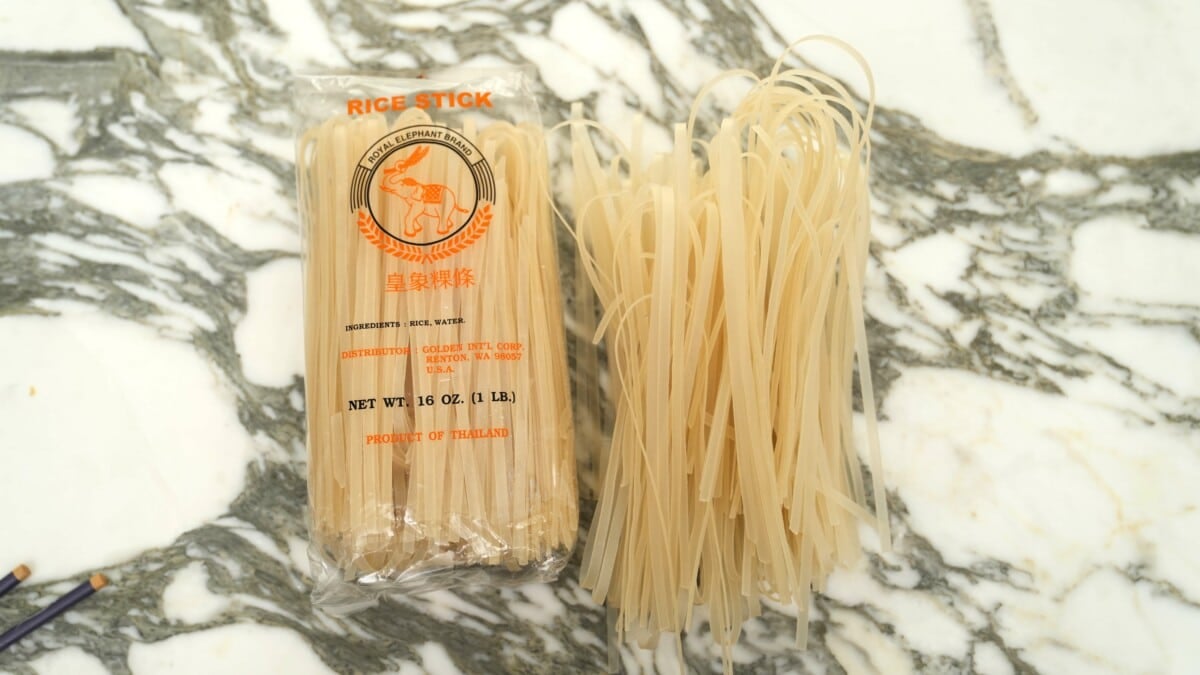
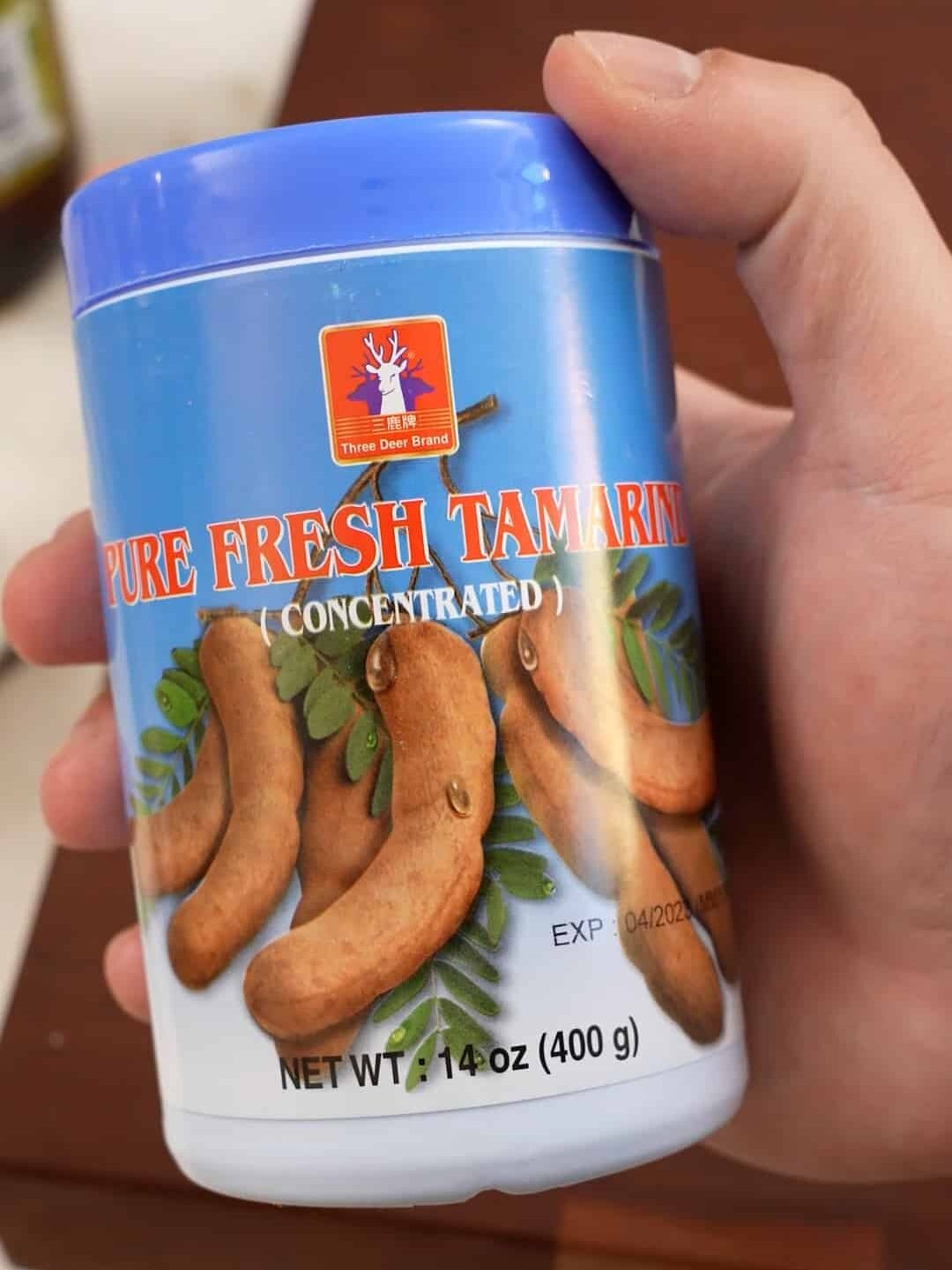
Recipe Instructions
1. Make Pad Thai Sauce
Mix together tamarind paste, fish sauce, and water. Roughly chop palm sugar and slowly melt over medium heat in a small saucepan until a dark blonde color. Once melted, immediately add your premixed sauce and stir until the sugar has dissolved and set aside.


2. Prepare Your Ingredients for Pad Thai
Chop your shallot, garlic, tofu, small shrimp, optional Thai chili peppers, and scallions. Clean mung bean sprouts. Set aside to be easily accessible once you start cooking.

3. Cook Shrimp, Aromatics, Tofu and Chilis
Over high heat add 1 tbsp of avocado oil and cook your shrimp (or preferred protein); once cooked, set aside.
Add 3 tbsp of oil over high heat and add your shallot, garlic, tofu, dried shrimp and optional Thai chili peppers. Stir fry for 30 seconds.
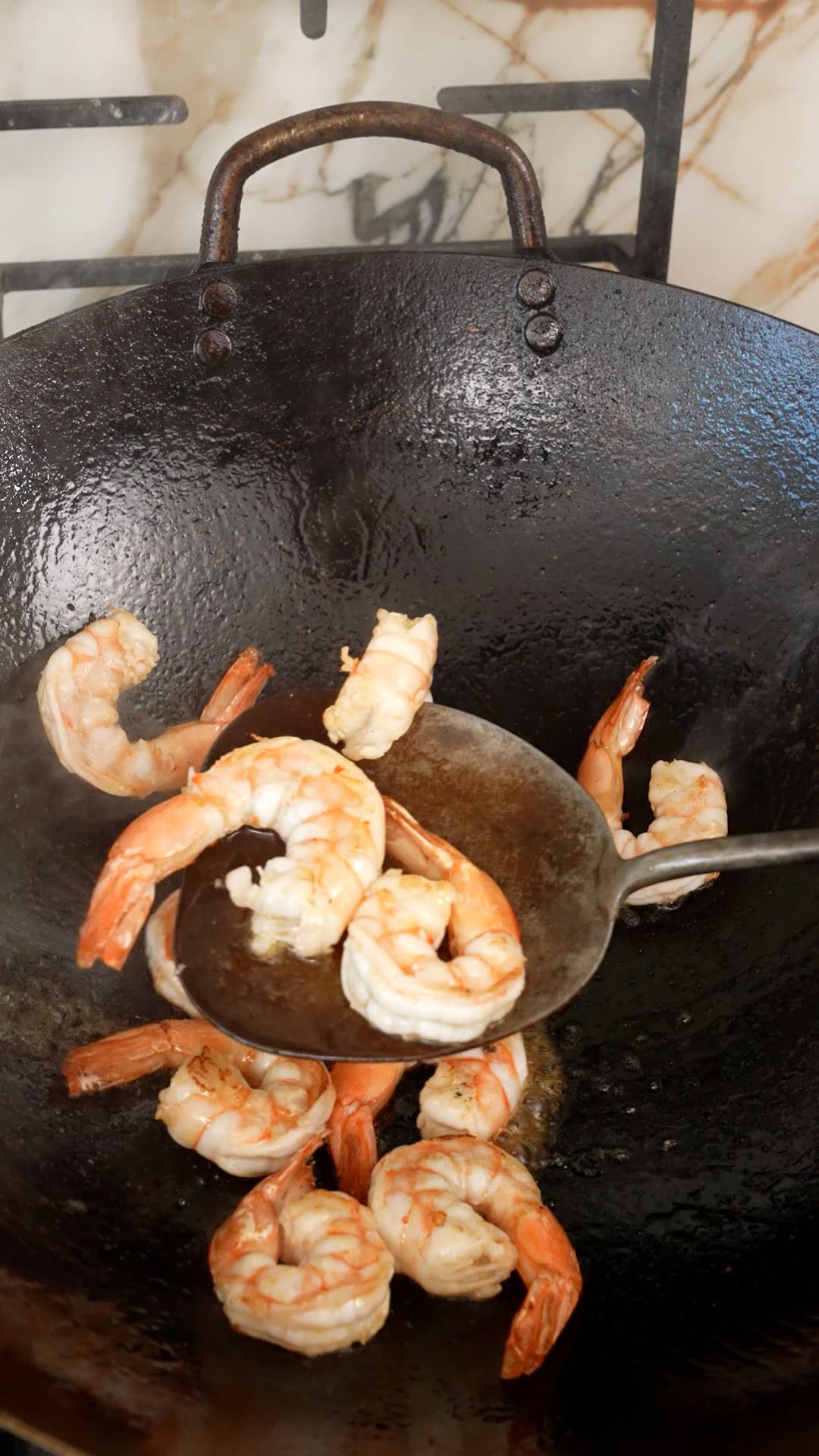
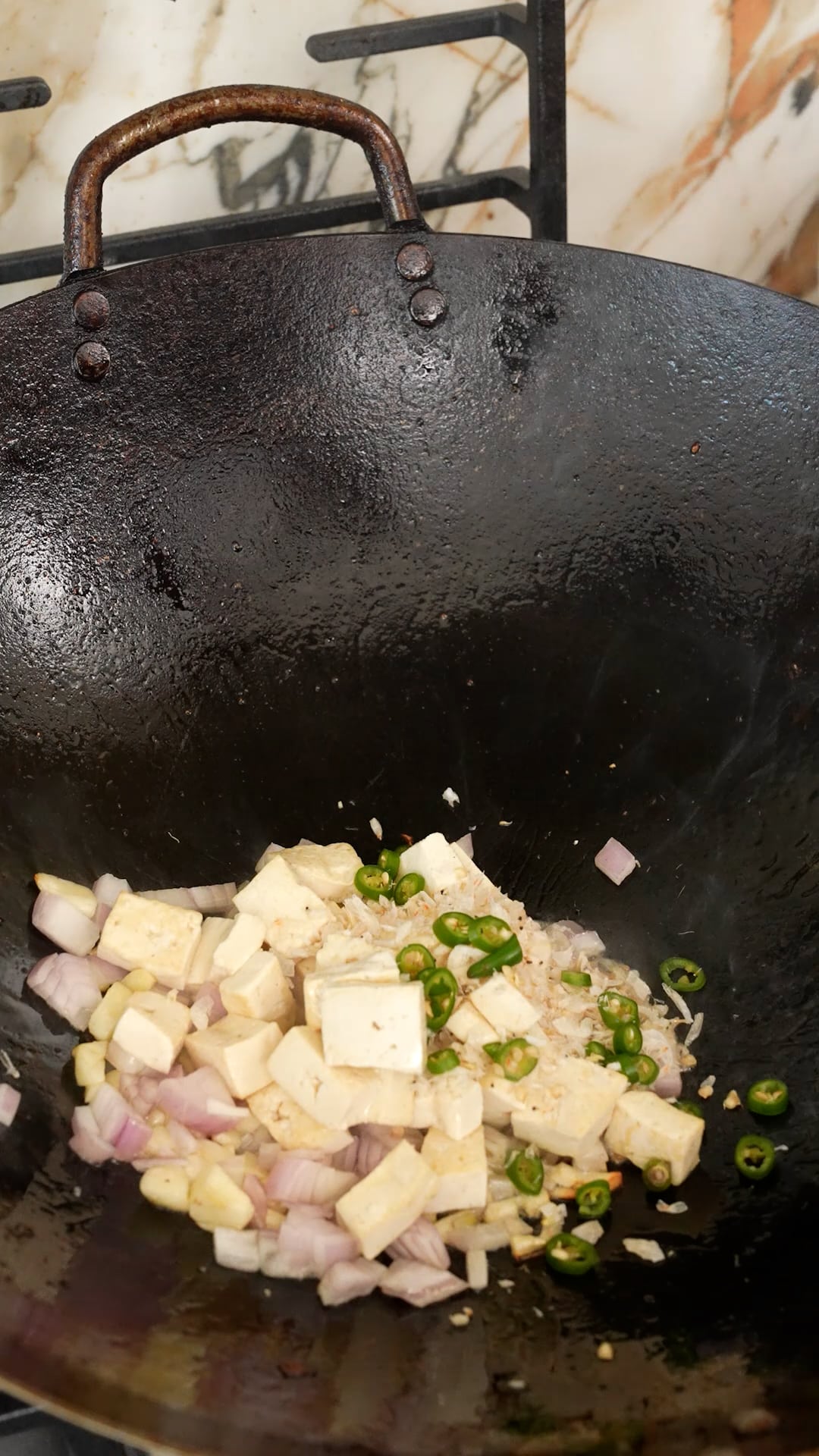
4. Add Your Noodles and Sauce
Next add your rice noodles. Pour in the Pad Thai sauce and mix to combine. Continue cooking over high heat 2-3 min until the Pad Thai sauce has incorporated into the noodles (taste test noodles for doneness).
At this stage, if the noodles are underdone, add 1/2 cup of water and continue cooking the noodles over high heat.
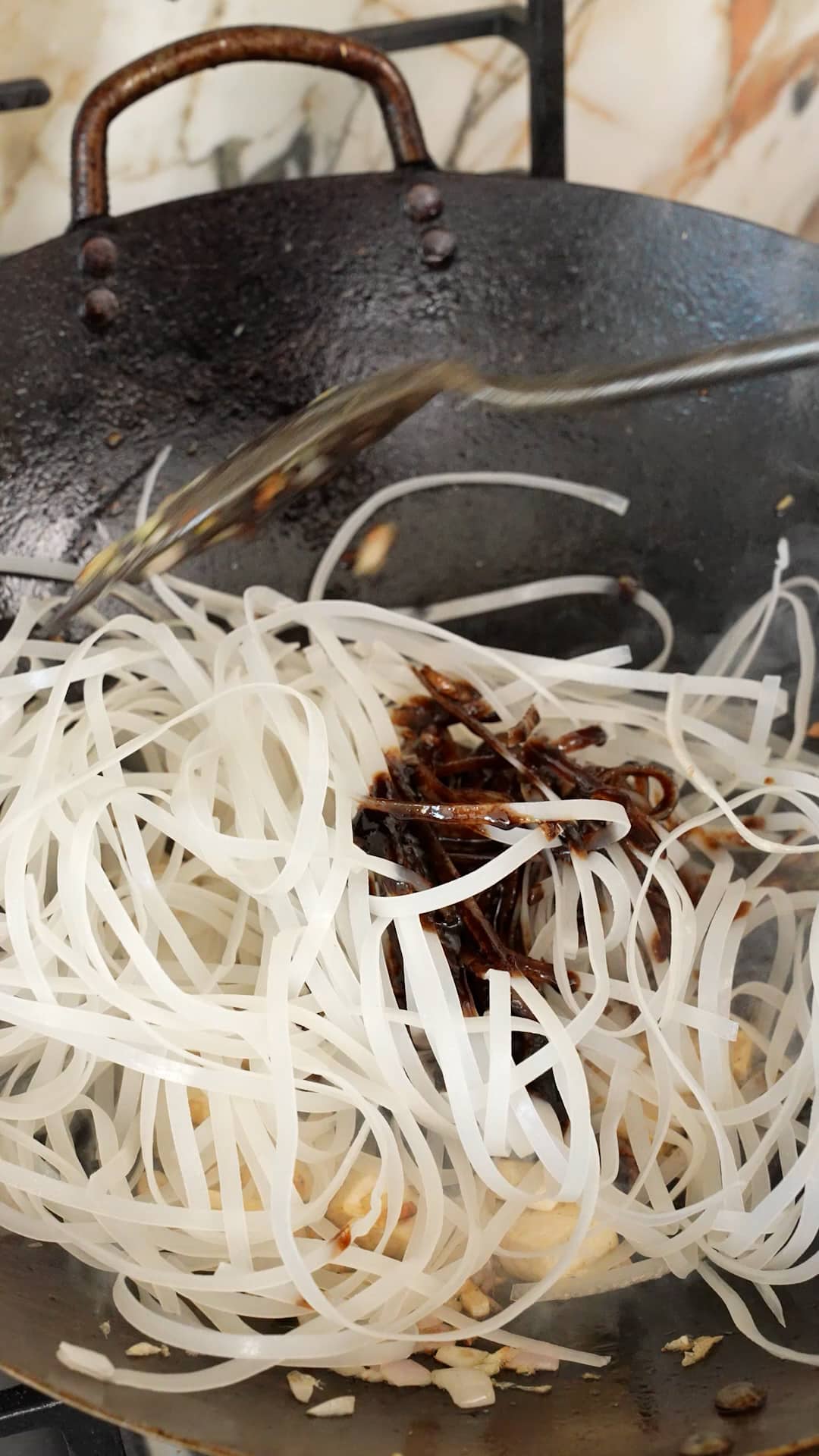
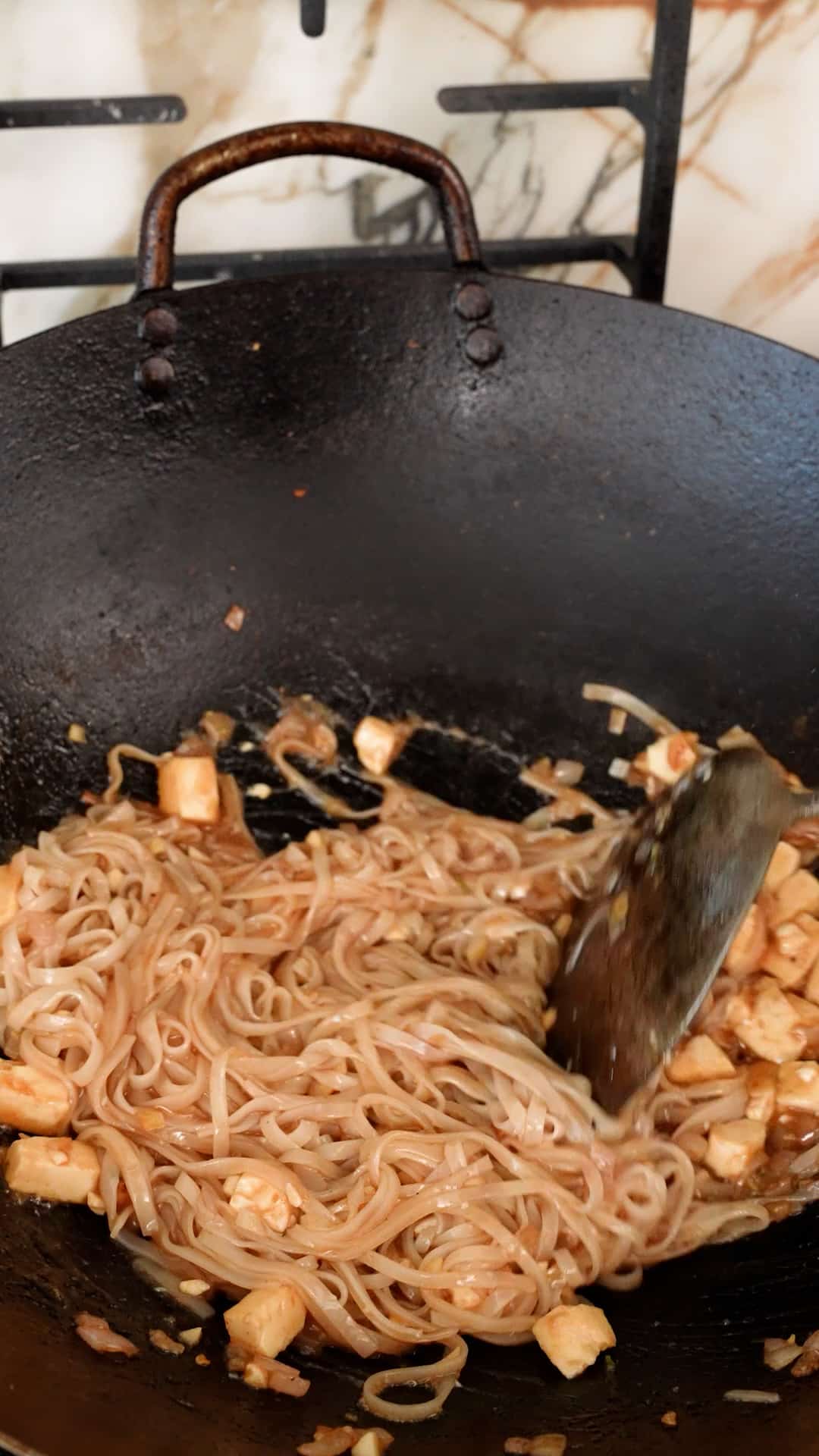
5. Cook Eggs and add Final Ingredients
Push noodles aside and add a bit of oil. Add 2 eggs and scramble until 90% done, then mix together with noodles.
Add scallions, bean sprouts and chopped peanuts and mix. Serve your Pad Thai with your optional garnishes: mung bean sprouts, chopped peanuts, lime, and chili flakes. Enjoy!
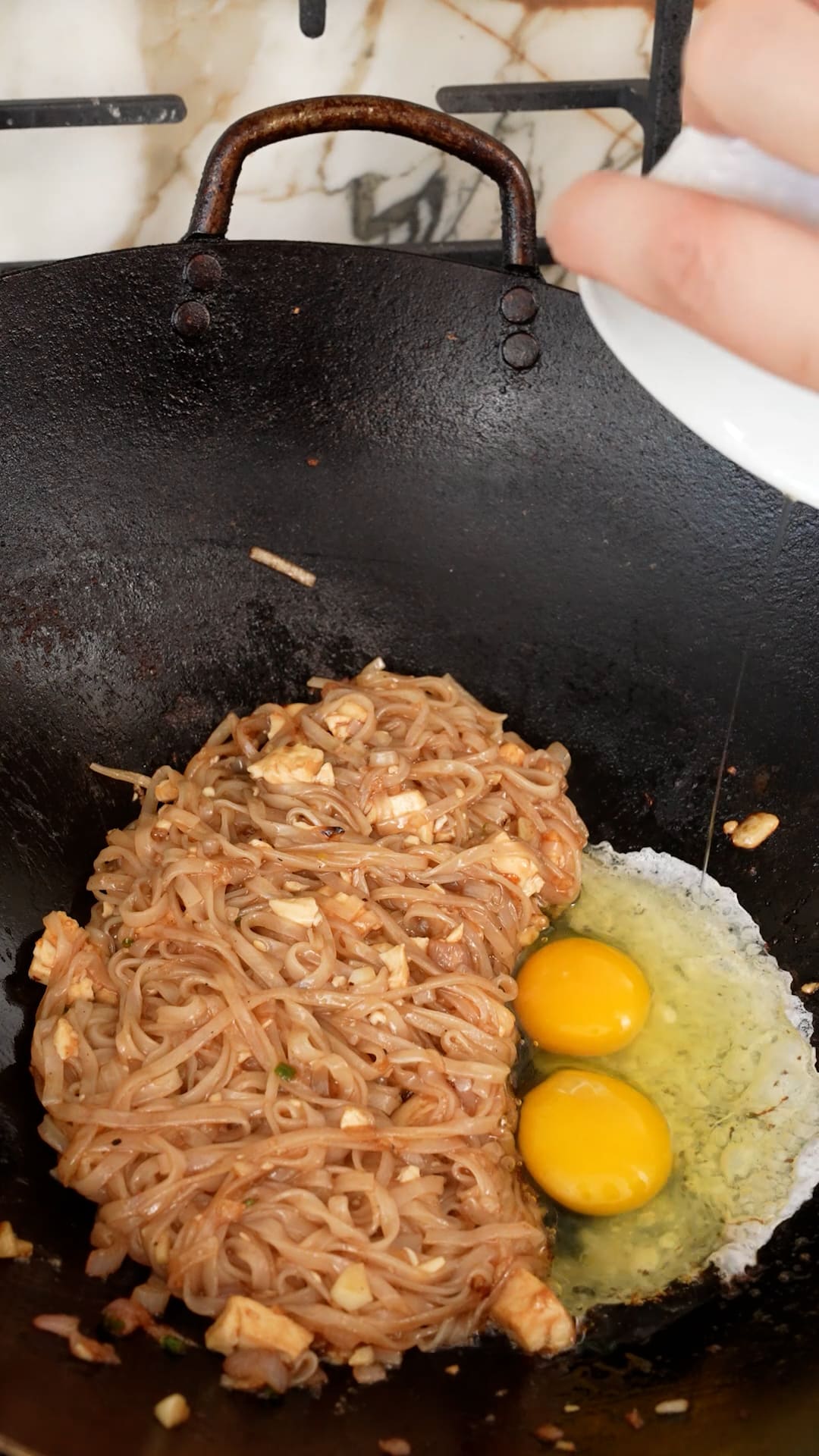

Pro Tips
Cooking Tips
Watch the Sugar
- If using palm sugar – keep a close eye on it as it melts, as sugar can burn.
- Once melted, add your pre-mixed Pad Thai sauce immediately and stir until the sugar has dissolved completely.
Do Not Crowd Your Pan
- Crowding your pan will lead to too much steam – this will cause your noodles to be steamed or boiled, rather than stir-fried. our noodles will become soggy.
- Your pan or wok needs to be large enough to avoid overcrowding. Overcrowding is something that we don’t talk enough about when cooking! There needs to be enough room around your ingredients so the steam can escape and your food can brown – otherwise, the trapped moisture and steam will make your dish soggy. It can also lead to your food cooking unevenly. Use a pan or wok that is large enough OR cook in batches.
Success is in the Prep
- Pad Thai is a dish that cooks FAST once you start – so make sure to have all of your ingredients prepped and ready to go ahead of time.
- I like to have each ingredient portioned and prepared in individual bowls so I can easily toss them in when it’s their turn.

Storage and Reheating
Pad Thai can be kept in an airtight container in the refrigerator for up to 3 days.
Rice noodles do not keep well – you will find that the noodles will begin to harden and the texture/bite will be different from when it’s fresh.
I like to rehydrate them in a hot pan or wok with a tiny bit of water. You can microwave leftovers as well, covered with a wet paper towel (to help steam).
Cooking With a Wok
By now, you know that I LOVE cooking with my carbon steel wok! It is my #1 most recommended kitchen tool, as I believe it is perfect for high-heat cooking and results in restaurant quality Chinese food!
If it is your first time cooking with a wok, make sure to read my “How To Season a Wok” post. There is a video included that shows exactly how to season your brand new wok and how to maintain it so it lasts for years.
If you cannot or do not want to use a wok, you can use a large pan, cast iron, or even a dutch oven.
If you tried this Pad Thai or any other recipe on my website, please leave a 🌟 star rating and let me know how it went in the comments below!
Pad Thai (Video)

Equipment
Ingredients
- 8 oz medium stick rice noodles, if used dried noodles, rehydrate in water for 1hr
- 1 small shallot, chopped
- 4 cloves garlic, chopped
- 1/4 cup firm tofu
- 2 tbsp dried small shrimp, finely chopped
- 2 thai chili peppers, chopped, optional
- 2 cups fresh bean sprouts
- 2 scallions, thinly sliced, lengthwise
- 2 eggs
- 1/4 lb shrimp, or protein of choice
Sauce
- 3 tbsp palm sugar, chopped
- 3 tbsp water
- 1/4 cup Thai tamarind paste
- 3 tbsp fish sauce
Optional Garnishes
- bean sprouts
- chopped peanuts
- chili flakes
- lime
Instructions
- Mix together tamarind paste, fish sauce, and water. Roughly chop palm sugar and slowly melt over medium heat in a small saucepan until a dark blonde color. Once melted, immediately add your premixed sauce and stir until the sugar has dissolved and set aside.
- Prepare your shallot, garlic, tofu, small shrimp, chilis, bean sprouts, and scallions and set aside.
- Over high heat add 1 tbsp of avocado oil and cook your protein and set aside.
- Add 3 tbsp of oil over high heat and add your shallot, garlic, tofu, dried shrimp and optional thai chili peppers. Stir fry for 30 seconds. Next add your rice noodles and sauce and mix to combine. Continue cooking over high heat 2-3 min until the sauce has incorporated into the noodles (test noodles for doneness).
- Push noodles aside and add a bit of oil. Add 2 eggs and scramble until 90% done, then mix together with noodles. Add scallions, bean sprouts and chopped peanuts and mix. Serve with more bean sprouts, chopped peanuts, lime, and chili pepper and enjoy!
Video
Notes
Nutrition
Nutrition information is automatically calculated, so should only be used as an approximation.


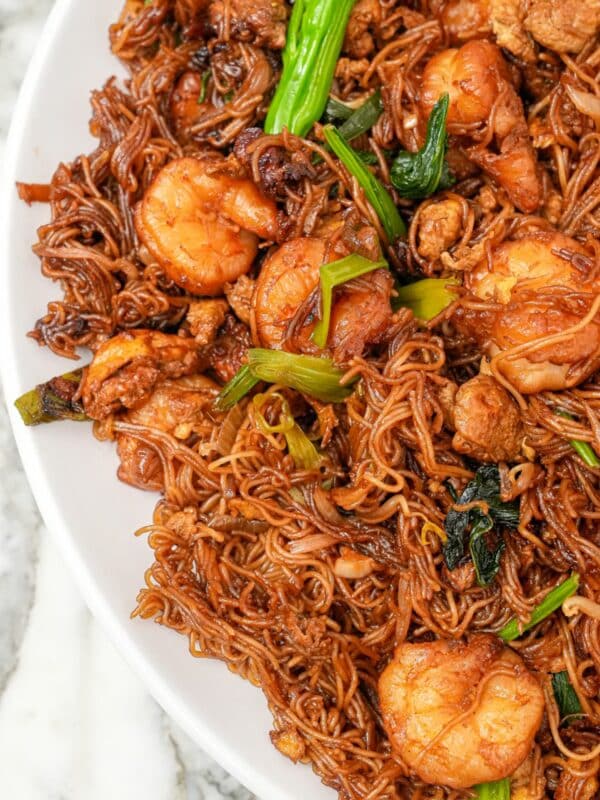
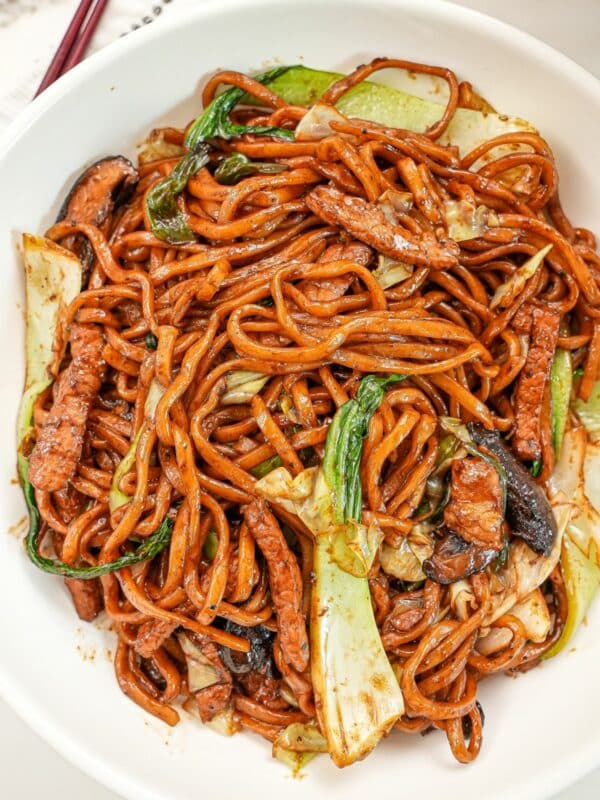
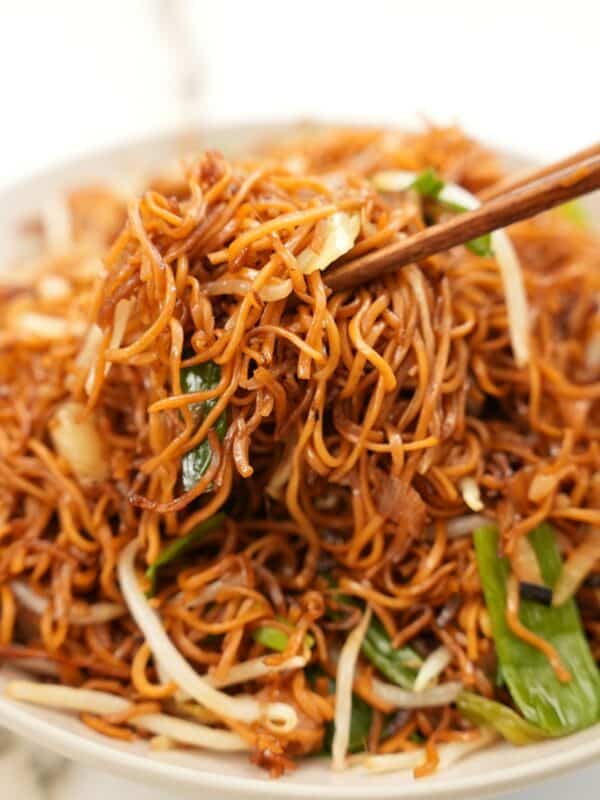







so yummy!!
Awesome can’t wait to try
Your Pad Thai is spot on perfect!
this was so good when I made it. it’s the only thing I ever order when I eat out, but I love that I can make it at home now.
This is one of my favourite dishes and I am so happy I could recreate it so quickly! The flavours are the perfect balance of sweet-savoury-sour and I just can’t get enough of it – I’ve been making it at least once per month!
Great recipe. Easy to follow and so tasty!